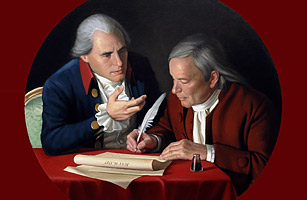
Thanks to — or sometimes no thanks to — the Connecticut Compromise, reached during the Constitutional Convention of 1787, the U.S. government has both a House of Representatives and a Senate. But it was a bit of a slog to reach the agreement. Under the proposed Virginia Plan, members of the House were to be nominated and elected by the people of the state. Members of the Senate, however, were to be nominated by state legislatures and elected by the lower house. That didn't sit well with less populous states like Delaware, which were afraid that they would be overshadowed by states with larger populations. Another plan, this time from New Jersey, proposed a legislature with a single house. That was also a no go. Finally, Roger Sherman and Oliver Ellsworth of the Connecticut delegation came up with a plan that melded the two earlier ideas. Members of the House would be allocated according to state population and elected by the people. Membership to the Senate would be limited to two per state, regardless of population, and state legislatures would choose Senators. After 11 days of voting, the compromise passed. But in 1913 the Seventeenth Amendment made it so that Senators would also be elected by the people.